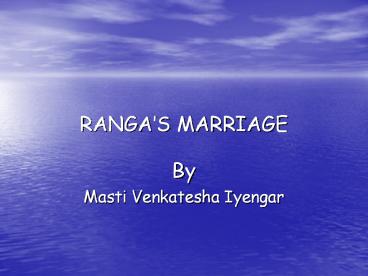RANGA’S MARRIAGE - PowerPoint PPT Presentation
1 / 13
Title:
RANGA’S MARRIAGE
Description:
RANGA S MARRIAGE By Masti Venkatesha Iyengar Ranga hails from Hosahalli, a village in Mysore. Like many other cultural aspects artistically portrayed by the author ... – PowerPoint PPT presentation
Number of Views:4282
Avg rating:3.0/5.0
Title: RANGA’S MARRIAGE
1
RANGAS MARRIAGE
- By
- Masti Venkatesha Iyengar
2
Ranga hails from Hosahalli, a village in Mysore.
Like many other cultural aspects artistically
portrayed by the author the custom of child
marriage too is typical to this village.
3
Ten years ago when the village accountant sent
his son Ranga to Bangalore for studies, the
situation in the village was different. People
never used to use English words while talking in
Kannada, their mother tongue. But now they do it
with an abominable pride
4
People are so fond of the foreign language and
education that Rangas homecoming is made a big
affair. People crowd around his house to see if
he has changed. They return home on finding no
significant change in him. The narrator is
particularly happy to find the boy still quite
cultured as he respectfully does 'namaskara'. The
narrator spontaneously blesses him saying 'May
you get married soon.'
5
But the boy is not ready for marriage, he says.
He is of the opinion that one should better
remain a bachelor than marry a young girl, as the
custom of the village is. The narrator is
disappointed to hear this, but as he sincerely
wants Ranga to get married and settled, he takes
a vow of getting him married.
6
He decides to get him married, a young girl of 11
by the name of Ratna, Rama Rao's niece, who has
of late come to Hosahalli to stay for a few
days.Now the narrator plans to make the
prospective bride and the bridegroom meet each
other.
7
He does by asking Rao's wife to send Ratna to
his house to fetch buttermilk. As Ratna arrives
she is asked to sing. As planned at that very
moment Ranga arrives and gets mesmerized by
Ratna's singing and almost instantly falls in
love with her being oblivious purposely
disappoints Ranga saying that Ratna is married.
8
The next morning the narrator meticulously plots
with Shastri, the fortune teller, to trap Ranga
and have him marry Ratna. He tutors him in what
is to be said and done when he will bring the boy
to him.
9
Shyama asks if there is any chance of
negotiation of marriage with Ratna bearing any
fruit, to which Shastri answers in the
affirmative. But once again the narrator pours
water on Ranga's hopes by saying that Ratna is
married.
10
On the way, the narrator enters Rama Rao's house
and comes out of the house to inform Ranga that
Ratna is unmarried and the previous information
about her marriage was wrong. Now visibly elated
Ranga's joys have no limits.
11
Ranga finally gets married to Ratna and fathers
two children moreover Ratna is now eight months
pregnant. The narrator is invited to the third
birthday of Ranga's child, who was named after
the narrator as 'Shyama'. On finding this, the
narrator mildly chides Ranga saying that he knows
that it is the English custom to name the child
after someone one likes, but it is not fair to
name him 'Shyama' because he is fair
complexioned.
12
All said and done, it is interesting to find how
Ranga forgets what he learned about happy
marriages in cities and gives in to the far
deeper influences that the village customs and
traditions have on him. And why not, is it easy
to do away with all that one learns so
unconsciously day and night in the society one
grows up in?
13
QUESTIONS1. Comment on the influence
of English the language and the way of life on
Indian life as reflected in the story. What is
the narrators attitude to English.2. Prepare
character sketch of all the characters in the
story Rangas marriage. 3. What did Ranga
think about marriage? Do you find any changes in
his attitude during the course of the story?4.
How did the narrator know that Ranga was really
interested in Ratna? How did he manage to get
Ranga married to Ratna? 5. Who is Ranga? How
did the people react when he returned after
studying from Bangalore? 6.What were the two
specialties of the narrators village?

